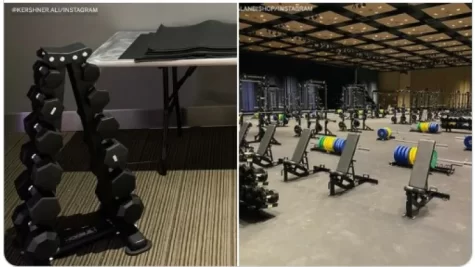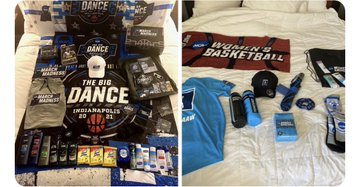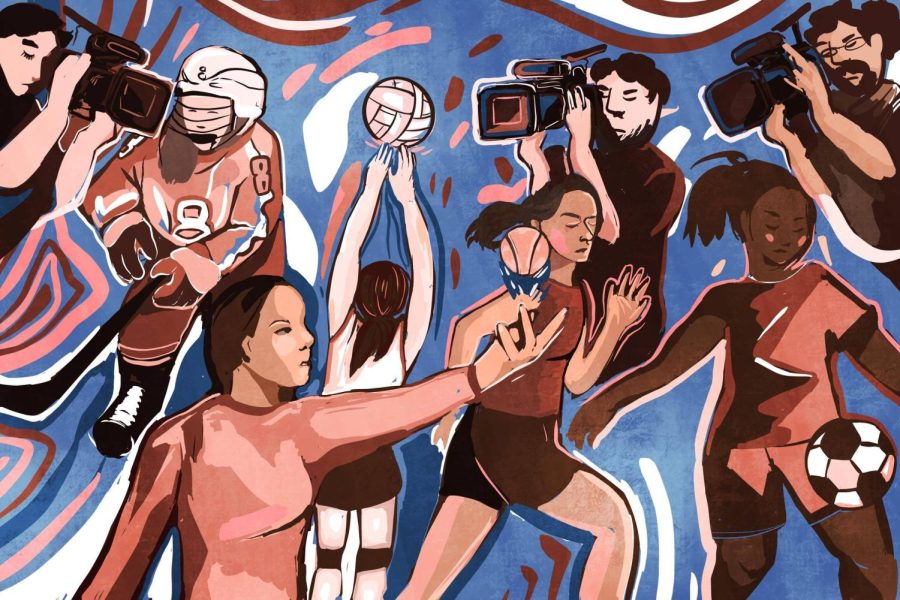Gender inequality in sports even in this day and age?
Photo by The Charlatan
April 12, 2022
If you thought inequality and sexism was over, think again because the treatment the women receive as players in the NCAA is completely different from those of the men’s team.

Everybody knows that the priority of men’s college sports compared to women’s college sports is a lot higher, but even in today’s day and age, the inequality that women’s NCAA basketball receives is ridiculous. In 2021, they had different facilities, food – even the SWAG that the team gets was different. All of the female basketball players who were a part of the NCAA tournament were given one rack of dumbbells and yoga mats while the men were given a fully equipped weight room with more than enough to meet their needs, reiterated by the New York Times. Additionally, the women were not given access to their facilities like the weight room until the Sweet 16, while the men were, once again, provided with what they needed to successfully compete and succeed in this tournament. This divide does not make any sense because the grind and effort it takes to reach the NCAA tournament is just as difficult for the women as the men. Are women able to dunk? Not really, but that does not mean the training or preparation for success is any easier. Just because there is a difference in gender and the schools they play against, doesn’t give the NCAA the right to treat one or the other as less worthy.
“Same sport. Same national tournament. Same number of teams. WBB only has access to 1 stationary bike and a “weight pyramid” for the first 2 rounds. WBB can’t use the weight room till the sweet 16. MBB has access to theirs right away,” said Zack Zillner, Texas’ director of Sports Performance, to USA Today.
Along with the facilities being very minimal for the women, the NCAA also treated them as though the muscles in their bodies were worth nothing. The dumbbells that they were given only went up to 50 lbs., even though college athletes who work out 7 days a week can definitely lift more than that. Once again, this idea and stigma of weakness that are placed on the female gender when it comes to athletics is unrealistic and offensive to those who are playing and want to play for a profession.
When the information about inequality got out to the public, the NCAA response was that there was not enough room for a fully-equipped weight room, however, in a TikTok taken by Oregon women’s basketball player Sedona Prince, she showed a large room that was completely empty that was filled with some chairs and folded up tables, shown in the New York Times article. This, once more, shows that there is still some inequality when it comes to men’s and women’s college sports, even though this inequality is not even caused by the players themselves. The players on the women’s teams support those of the men’s and vice versa; it is genuinely only the NCAA that still sees a difference.
It is true that men and women differ physically, and that men have a greater muscle mass than women, which can show that they are somewhat “stronger” according to Great Courses Daily, but that fact does not mean that women are not strong, nor less-deserving of the same facilities. I am sure that the NCAA is not intentionally trying to call women “weak”, but by only putting out dumbbells that are 50 pounds and less, the organization is implying that these women are unable to lift above that weight.

Facilities are not the only thing that was unfair when it came to the NCAA tournament in 2021: the SWAG bag (merchandise given by the tournament) was less when compared to the men’s. In these SWAG bags, male players were given items upon items, including t-shirts, banners, multiple deodorants, towels, etc. while the women were given maybe a quarter of the things that the men received. What the men received was explained on The Spun for reference. Such disparity is diminishing the success and struggle that women’s teams have had to go to to reach the same place as the men have. The idea that these women are not deserving of the amount of SWAG that the men get is not fair and should be changed. Yet, when this inequality was brought to the NCAA’s attention, they said that the women had gotten a lesser amount because the NCAA does not extend the “March Madness” and the “Big Dance” branding to the women’s tournament. The NCAA response to this was that they will discuss it “in the near future”, coming from Promo Marketing Magazine. This is an absolute excuse for their sexism and their belief that men should have more priority, is not what should happen in 2021.
“Soo NCAA, this is how y’all are doing our queens?!!! We can’t tolerate this! They deserve more!” Kyrie Irving wrote on his Instagram Stories, according to Fox News.
Plus, the gender divide is not only happening in women’s college basketball, but there have been other situations like this one with women’s college softball including women having to play doubleheaders with only one week in the tournament while the men have two weeks to compete, states AP news. There is no reason that we should be pushing these girls to perform until they physically can’t anymore, while the men get the luxury of rest.
“There is no answer that the NCAA executive leadership led by Mark Emmert can give to explain the disparities. Mark Emmert and his team point black chose to create them! The real issue is not the weights or the “swag” bags; it’s that they did not think or do not think that the women’s players “deserve” the same amenities of the men,” said South Carolina Coach Dawn Staley on Swish Appeal.
Personally, I think the only way that this inequality and sexism will be able to be fixed is if humanity changes its mindset. Women work and train to get to the NCAA tournament. Men work and train to get to the NCAA tournament. Women practice 7 days a week. So do men. Men workout most days. So do women. The exercises and play might be different per each team, but that does not mean that the effort and strength that it takes to get to March Madness is any different. At the end of the day, it is not the players who are diminishing each other, but rather the viewers and corporations.







